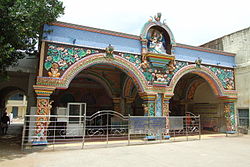

| Maharaja Serfoji's Sarasvati Mahal Library | |
|---|---|

Maharaja Serfoji's Sarasvati Mahal Library
| |
 | |
| Location | Thanjavur, India |
| Type | Medieval library |
| Established | 16th century |
| Branches | N/A |
| Collection | |
| Items collected | Books and Manuscripts |
| Size | More than 49,000 |
| Access and use | |
| Circulation | Open to public |
| Other information | |
| Website | tmssmlibrary.com |
Saraswathi Mahal Library, also called Thanjavur Maharaja Serfoji's Saraswathi Mahal Library is a library located in Thanjavur (Tanjore), Tamil Nadu, India. It is one of the oldest libraries in Asia[1] established during 16th century by Nayakar kings of Thanjavur and has on display a rare collection of Palm leaf manuscripts and paper written in Tamil and Sanskrit and a few other indigenous languages of india (especially southern regional languages). The collection comprises well over 49,000 volumes, though only a tiny fraction of these are on display. The library has a complete catalog of holdings, which is being made available online. Some rare holdings can be viewed on site by prior arrangement.[2] Encyclopedia Britannica mentions the library as the "Most remarkable library of India".[3]
The Saraswathi Mahal library was started by Nayak Kings of Tanjavur as a Royal Library for the private intellectual enrichment of Kings and their family of Thanjavur (see Nayaks of Tanjore) who ruled from 1535 CE till 1676 CE.[4] The Maratha rulers who captured Thanjavur in 1675 promoted local culture and further developed the Royal Palace Library until 1855. Most notable among the Maratha Kings was Serfoji II (1798–1832), who was an eminent scholar in many branches of learning and the arts. In his early age Sarfoji studied under the influence of the German Reverent Schwartz, and learned many languages including English, French, Italian and Latin. He enthusiastically took special interest in the enrichment of the Library, employing many Pandits to collect, buy and copy a vast number of works from all renowned Centres of Sanskrit learning in Northern India and other far-flung areas.
During 1918 the Saraswathi Mahal Library was open to public.[5] The Library is located within the campus of Tanjavur palace.[6]

The library is open to the public; it also supports efforts to publish rare manuscripts from the collection, as well as ensuring all volumes are preserved on microfilm. The Library has installed computers in 1998 for the Computerisation of Library activities. As a first phase, the Library catalogues are being stored in the Computer for easy information retrieval. It is also proposed to digitalise the manuscripts of this Library shortly.[7]
The bulk of the manuscripts (39,300) are in Tamil and Sanskrit. Manuscripts number over 4500, comprising titles in literature and medicine. The Library has a collection of 3076 Marathi manuscripts from the South Indian Maharastrian of the 17th, 18th, and 19th centuries; this includes the hierarchy of the Saints of Maharashtra belonging to Sri Ramadasi and Dattatreya Mutts. The Marathi manuscripts are mostly on paper but a few were written in Telugu script on palm-leaf. There are 846 Telugu manuscripts in the holdings, mostly on palm leaf. There are 22 Persian and Urdu manuscripts mostly of 19th century also within the collection. The library also holds medical records of Ayurveda scholars, including patient case studies and interviews in the manuscripts classified under the Dhanvantari section.
Apart from these manuscripts there are 1342 bundles of Maratha Raj records available at the Library. The Raj records were written in the Modi script (fast script for Devanagari) of the Marathi language. These records encompass the information of the political, cultural and social administration of the Maratha kings of Thanjavur.[8]
Efforts were made to microfilm and catalogue the contents way back in 1965 when Indira Gandhi was Information and Broadcasting Minister, Government of India who sanctioned the fund for the library's development. Since then no efforts were made to scan the documents and computerise the same using present day technology. It is also a designated 'Manuscript Conservation Centre' (MCC) under the National Mission for Manuscripts established in 2003.[9]
{{cite web}}: CS1 maint: archived copy as title (link)
{{cite web}}: CS1 maint: archived copy as title (link)
|
| ||
|---|---|---|
| District headquarters |
| |
| Country |
| |
| State |
| |
| Region |
| |
| Divisions |
| |
| Taluks |
| |
| Revenue blocks |
| |
| Municipal corporations |
| |
| Municipalities |
| |
| Rivers |
| |
| History |
| |
| Places of interest |
| |
| Religious and monastic institutions |
| |
| Universities |
| |
| ||
10°47′29″N 79°8′10″E / 10.79139°N 79.13611°E / 10.79139; 79.13611